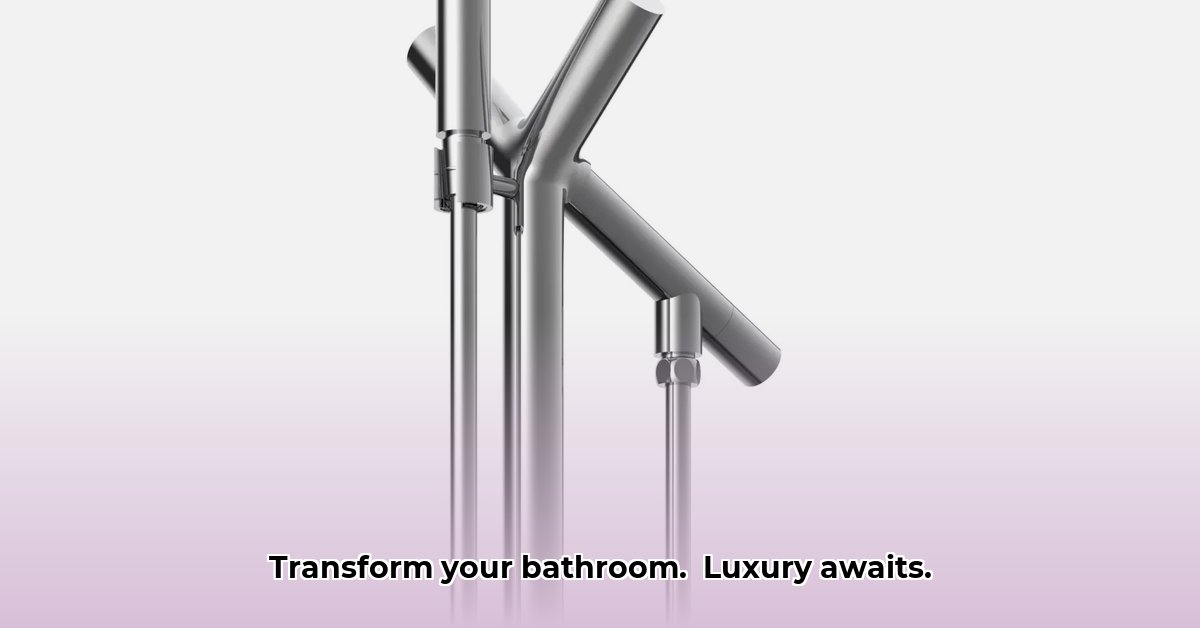Want a bathroom that feels like a luxurious spa? A Roman tub is the way to go! This guide will walk you through everything you need to know, from figuring out if one will even fit in your bathroom and picking the best material, to installing it and keeping it looking great for years. We’ll cover why people love Roman tubs, how to choose the perfect one for your space and budget, and how to keep it sparkling clean. Get ready to turn your bathroom into your own personal relaxation haven.
Roman Tub Installation: Your Guide to Luxurious Soaking
Transform your bathroom into a personal sanctuary with a Roman tub. These deep, spacious tubs offer an unparalleled bathing experience, but installing one requires careful planning and execution. This guide will walk you through everything you need to know, from choosing the right tub to enjoying years of luxurious soaks.
Understanding Roman Tubs: History, Design, and Benefits
Roman tubs, inspired by the elaborate bathhouses of ancient Rome, are designed for deep, immersive soaking. Unlike standard bathtubs, they offer a generous depth, allowing you to fully submerge and relax.
Historical Significance: The ancient Romans valued bathing as a social and therapeutic ritual. Their bathhouses were grand complexes with various pools, saunas, and relaxation areas. Modern Roman tubs aim to recreate this luxurious and therapeutic experience in your home.
Design Features: Roman tubs are typically characterized by their:
- Depth: Significantly deeper than standard tubs, often exceeding 20 inches.
- Size: Larger overall dimensions, providing ample space for stretching out.
- Deck-Mounted Faucets: Faucets are installed on a wide, flat rim (deck) around the tub, adding to the aesthetic appeal.
- Material Options: Available in a variety of materials, each offering different benefits.
Benefits of a Roman Tub:
- Enhanced Relaxation: The deep soaking experience promotes relaxation and stress relief.
- Therapeutic Benefits: Warm water immersion can ease muscle tension and joint pain.
- Luxurious Aesthetic: Adds a touch of elegance and sophistication to any bathroom, increasing the overall aesthetic value.
- Increased Home Value: A well-installed Roman tub can be a desirable feature for potential buyers.
Choosing Your Roman Tub: Material Matters
The first big decision is the tub’s material. Each type brings a different mix of looks, durability, and price, impacting both aesthetics and functionality. Let’s explore your options:
- Acrylic: Acrylic tubs are lightweight and budget-friendly. They’re easy to clean, making them a practical choice. However, they might not hold heat as well as other materials.
- Cast Iron: These tubs are incredibly durable and known for their exceptional heat retention. They exude a classic, elegant charm, but be prepared for a heftier price tag and the need for some serious muscle to maneuver them into place, which means reinforcement might be needed.
- Stone Resin: Stone resin offers a fantastic compromise. These composite tubs combine the durability and heat retention of cast iron with the lighter weight and more modern aesthetic of acrylic. They’re a premium option, but many find the superior performance worth the investment.
Think about your priorities: Do you need a durable, heat-retaining tub, even if it costs more? Or would a lighter, more affordable option suit your needs better? The right choice depends entirely on your personal situation and preferences.
Space Planning and Plumbing: Essential Pre-Installation Steps
Before you even think about ordering your tub, careful planning is key. Measure everything twice – or even three times! Trust us, you don’t want to discover your dream tub won’t fit after it’s already arrived.
-
Space Requirements: Roman tubs are substantial, requiring careful planning and exact measurements. You need ample space, considering not just the tub’s dimensions but also comfortable access, surrounding fixtures, and any potential obstacles.
-
Plumbing Considerations: Professional help is strongly recommended for installing the water supply and drainage lines. You need to consider your home’s water pressure and drainage capacity. An underpowered system can lead to a disappointing and frustrating experience.
-
Accessibility Features: Prioritize accessibility from the outset. Incorporate features like grab bars and a low entry threshold to make the tub safer and more comfortable for everyone, especially those with mobility issues.
-
Weight Considerations: Roman tubs, especially those made of cast iron or stone resin, can be very heavy. Ensure your floor structure can support the weight of the tub filled with water. Consult a structural engineer if necessary.
-
Local Codes and Permits: Check your local building codes and obtain any necessary permits before starting the installation. This will help prevent any legal issues or delays down the road.
-
Faucet Selection: Choose a Roman tub faucet that complements the style of your bathroom and provides adequate water flow. Deck-mounted faucets are typically required for Roman tubs.
-
Drainage: Ensure the drain is appropriately sized to handle the increased water volume of a Roman tub. Installing a larger drainpipe might be necessary.
-
Water Heater Capacity: Consider your water heater’s capacity. Roman tubs require a significant amount of hot water, so a larger water heater might be necessary to ensure a comfortable bathing experience.
-
Electrical Considerations: If you plan to add features like jets or a heated backrest, ensure you have the appropriate electrical outlets and wiring installed by a qualified electrician.
Installation Steps: A Detailed Overview
While you could theoretically tackle a Roman tub installation yourself, professional installation is highly recommended, especially for those with limited plumbing experience. A professional plumber will ensure proper installation, preventing future leaks and headaches.
Here’s a general overview of the steps involved:
-
Preparation: Thoroughly clear the area around the installation site. Double-check all plumbing connections and ensure everything is ready.
-
Positioning: Carefully and precisely position the tub, verifying its alignment and ensuring everything is level.
-
Plumbing Connections: Connect the water supply and drainage lines securely. This is a critical step that requires expertise.
-
Securing the Tub: Once the plumbing is correctly connected, firmly secure the tub in its designated location. This prevents shifting or movement, ensuring a stable and safe tub for years to come.
-
Finishing Touches: Connect the faucet and any other fixtures with precision. Thoroughly test the plumbing for any leaks before finishing.
Detailed Steps:
- Subfloor Preparation: Ensure the subfloor is level and structurally sound. Reinforce if necessary to support the weight.
- Framing (if required): Build a frame to support the tub and create a level surface.
- Plumbing Rough-in: Install drain and water supply lines according to manufacturer’s instructions and local codes. Leave enough access for future maintenance.
- Setting the Tub: Carefully lower the tub into the framed area. Use shims to ensure it’s perfectly level.
- Connecting Drain and Overflow: Connect the drain and overflow to the plumbing system, ensuring watertight seals.
- Connecting Water Supply: Connect hot and cold water lines to the faucet, checking for leaks.
- Testing: Fill the tub with water to check for leaks around the drain, overflow, and faucet connections.
- Insulation (optional): Insulate around the tub to improve heat retention.
- Finishing: Install tile, stone, or other finishing materials around the tub deck to create a seamless look.
- Caulking: Apply caulk around the perimeter of the tub where it meets the floor and walls to prevent water damage.
Maintenance and Care: Keeping Your Roman Tub Sparkling
Regular maintenance is key to extending the lifespan of your beautiful Roman tub and keeping it looking its best. The type of maintenance will depend on the material, therefore understanding the specifics is very important.
| Material | Cleaning Method | Maintenance Tips |
|---|---|---|
| Acrylic | Gentle cleaning with mild soap and water; avoid harsh chemicals or abrasive cleaners. | Regularly inspect for any cracks or scratches. Promptly address any issues to prevent further damage. |
| Cast Iron | Clean with mild soap and water; avoid abrasive cleaners that could scratch the enamel surface. | Regularly check the caulking around the tub’s edges. Reapply sealant as needed to prevent leaks, ensuring the integrity of the installation. |
| Stone Resin | Clean with mild soap and water. Avoid abrasive cleaners, as these could affect the integrity and finish of the tub. | Periodically seal the surface. This helps prevent staining and keeps the tub looking its best. |
Additional Tips:
- Regular Cleaning: Clean your tub regularly to prevent soap scum and mineral buildup.
- Avoid Harsh Chemicals: Use gentle, non-abrasive cleaners specifically designed for your tub’s material.
- Protect the Finish: Avoid dropping heavy objects or using abrasive cleaning tools that can scratch the surface.
- Check Caulking: Inspect the caulking around the tub regularly and re-caulk as needed to prevent water damage.
- Maintain Faucets: Clean and maintain your Roman tub faucets to prevent mineral buildup and ensure smooth operation.
Choosing the Right Roman Tub
Ready to find your perfect Roman tub? Consider these factors:
*
- Gray Kitchen Backsplash Tile: Ideas for a Stylish Upgrade - December 14, 2025
- Backsplash For Gray Cabinets: Choosing the Right Backsplash Style - December 13, 2025
- Gray And White Backsplash: Ideas For Timeless Style - December 12, 2025









